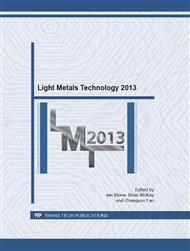p.644
p.648
p.653
p.658
p.663
p.668
p.673
p.678
p.683
Influence of the Organic Additions on Structure, Corrosion Resistance and Tribological Properties of Ni/Al2O3 Composite Coatings
Abstract:
Composite Ni/Al2O3 coatings were electrochemically deposited from a Watts bath modified with the organic additions of dioctyl sulphosuccinate sodium salt C20H37NaO7S–(DSS) and 2,3-dihydroxy-1,2 benzisothiazol-3-one 1,1-dioxide C7H5NO3–(LSA). The effect of different amount (50 and 100 g/l) of Al2O3 powder and organic additions on microstructure, microhardness, corrosion resistance and tribological properties was investigated. The coatings were examined by optical microscopy, scanning electron microscopy (SEM), energy dispersive X-ray analysis (EDX) and X-ray diffraction (XRD) techniques. The electrochemical behaviour of the coatings in corrosive solutions (1 M NaCl and 1 M Na2SO4) was investigated by potentiodynamic polarisation. The tribological properties were investigated by the Taber abrasive wear test, a standard test often applied in industrial practice. The results show that Al2O3 particles are uniformly distributed in the composite coatings compared with coatings without organic additions. The addition of organic compounds also reduced the size of the forming nickel crystallites and improved the tribological and corrosion properties of coatings containing the dispersed hard particles of Al2O3 added in an amount of 50 g/l and the addition of organic LSA and DSS compounds.
Info:
Periodical:
Pages:
663-667
Citation:
Online since:
July 2013
Keywords:
Price:
Сopyright:
© 2013 Trans Tech Publications Ltd. All Rights Reserved
Share:
Citation:


